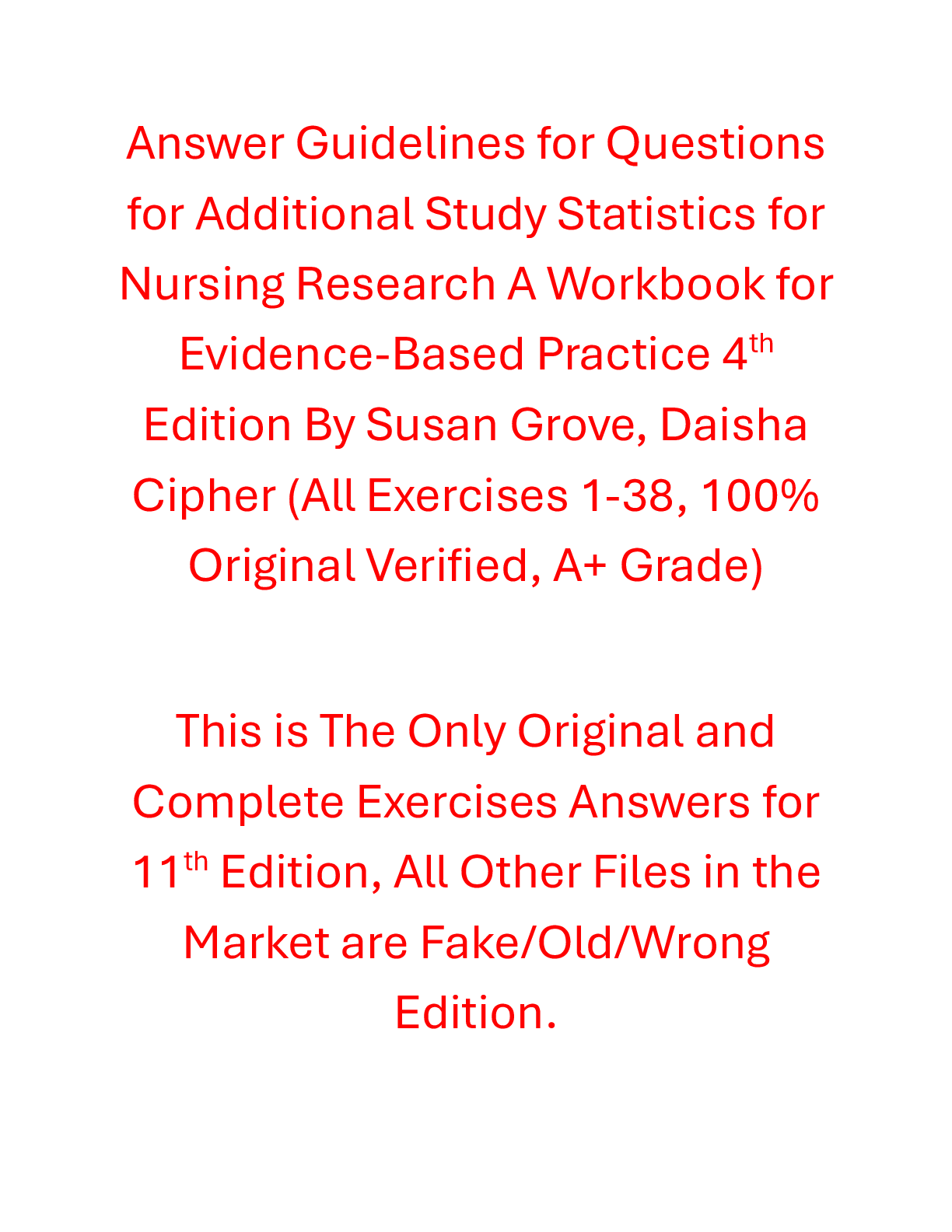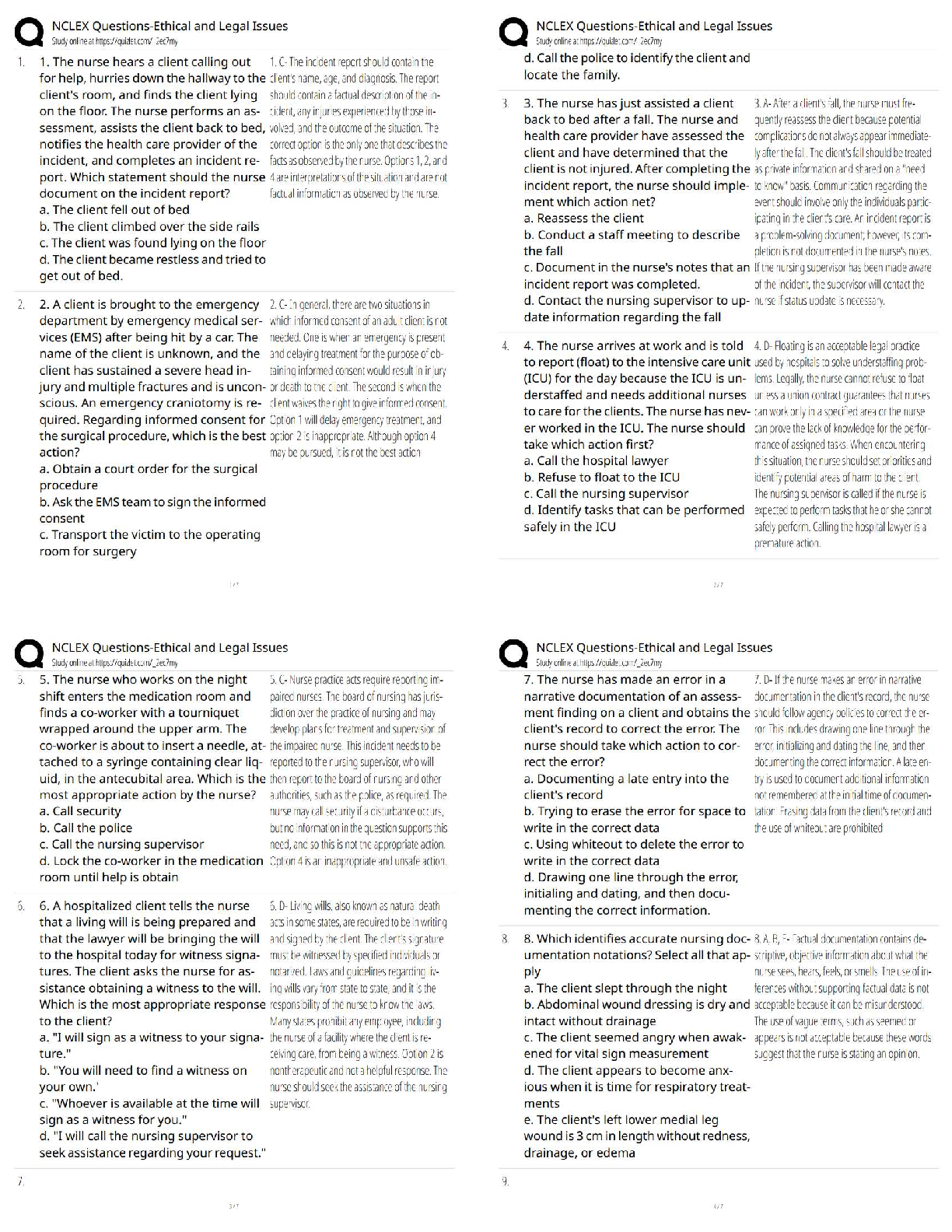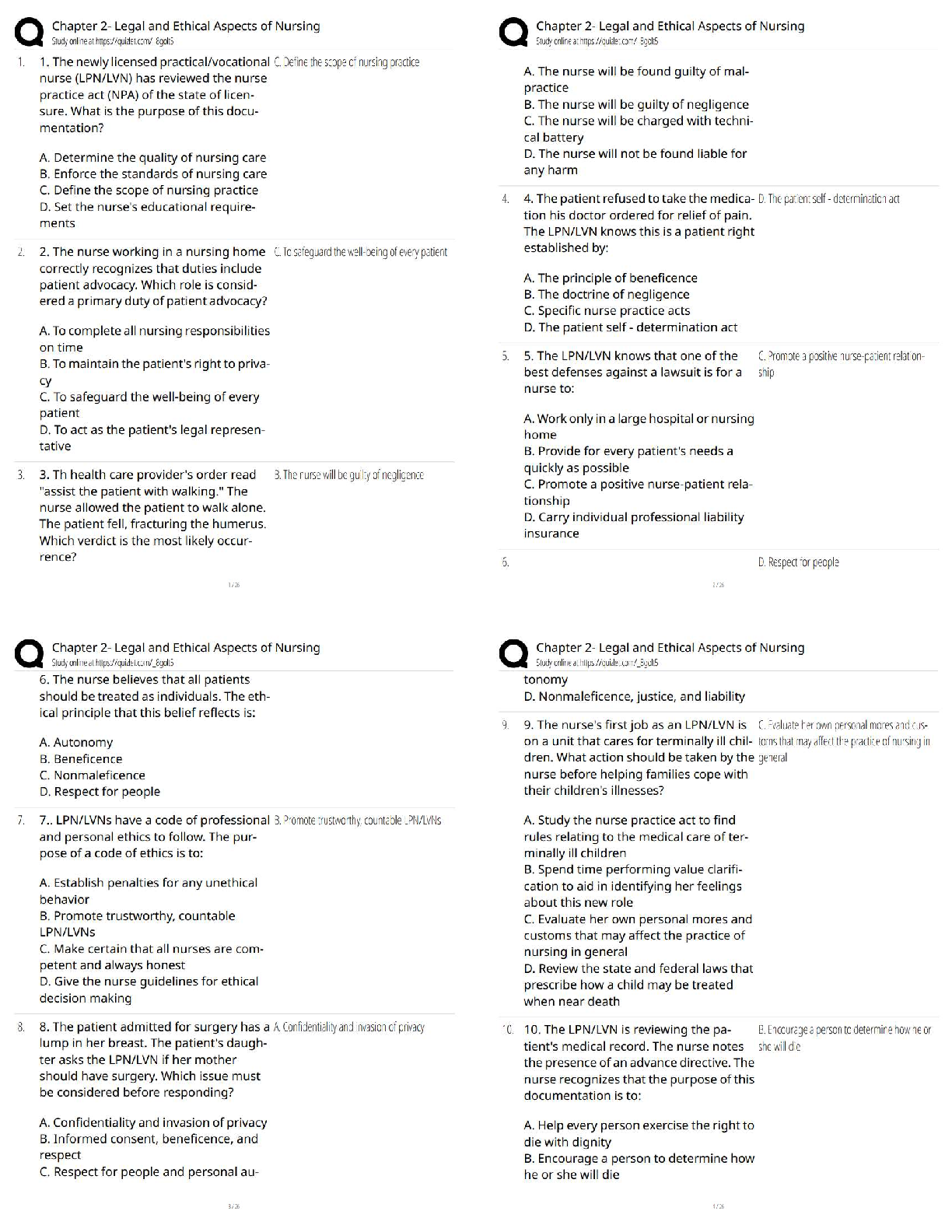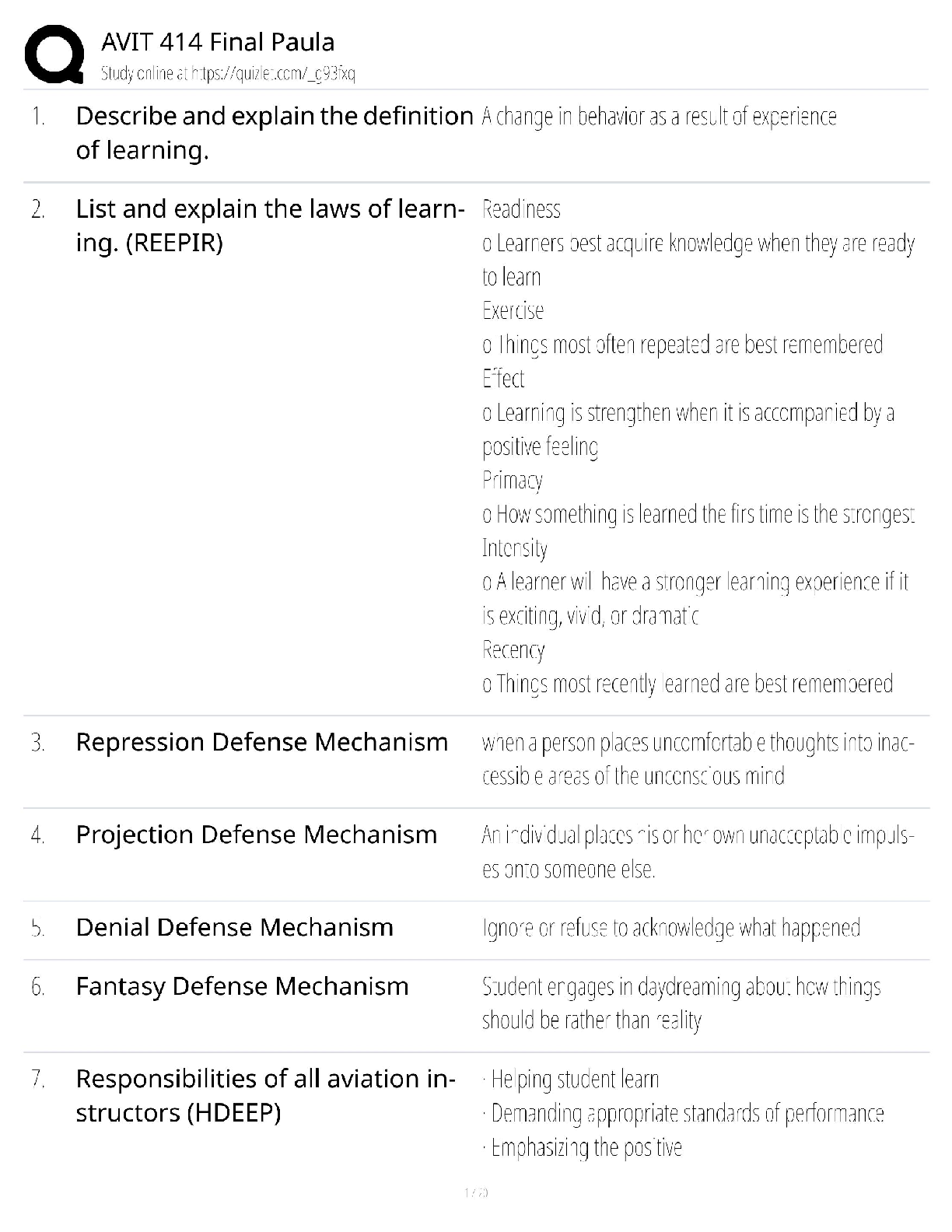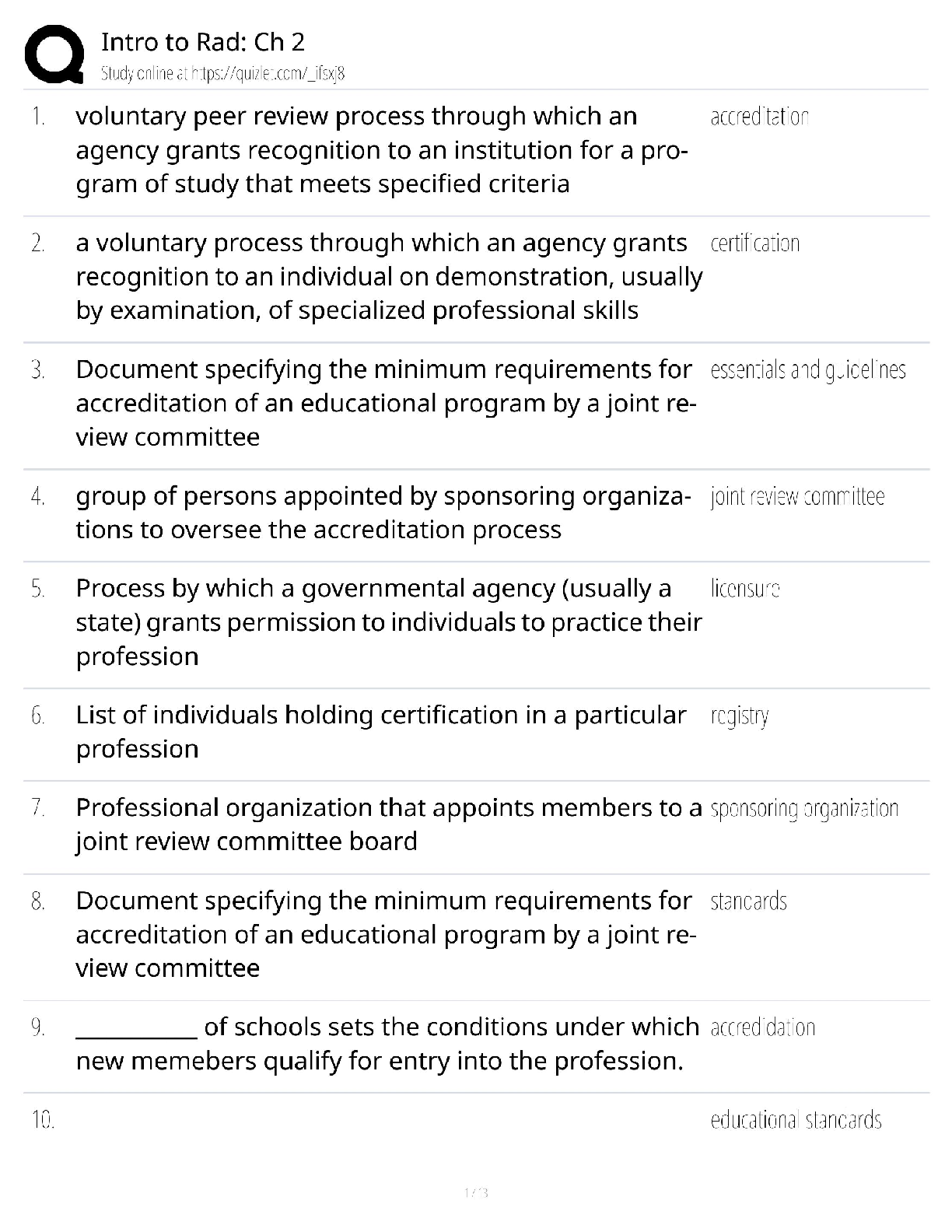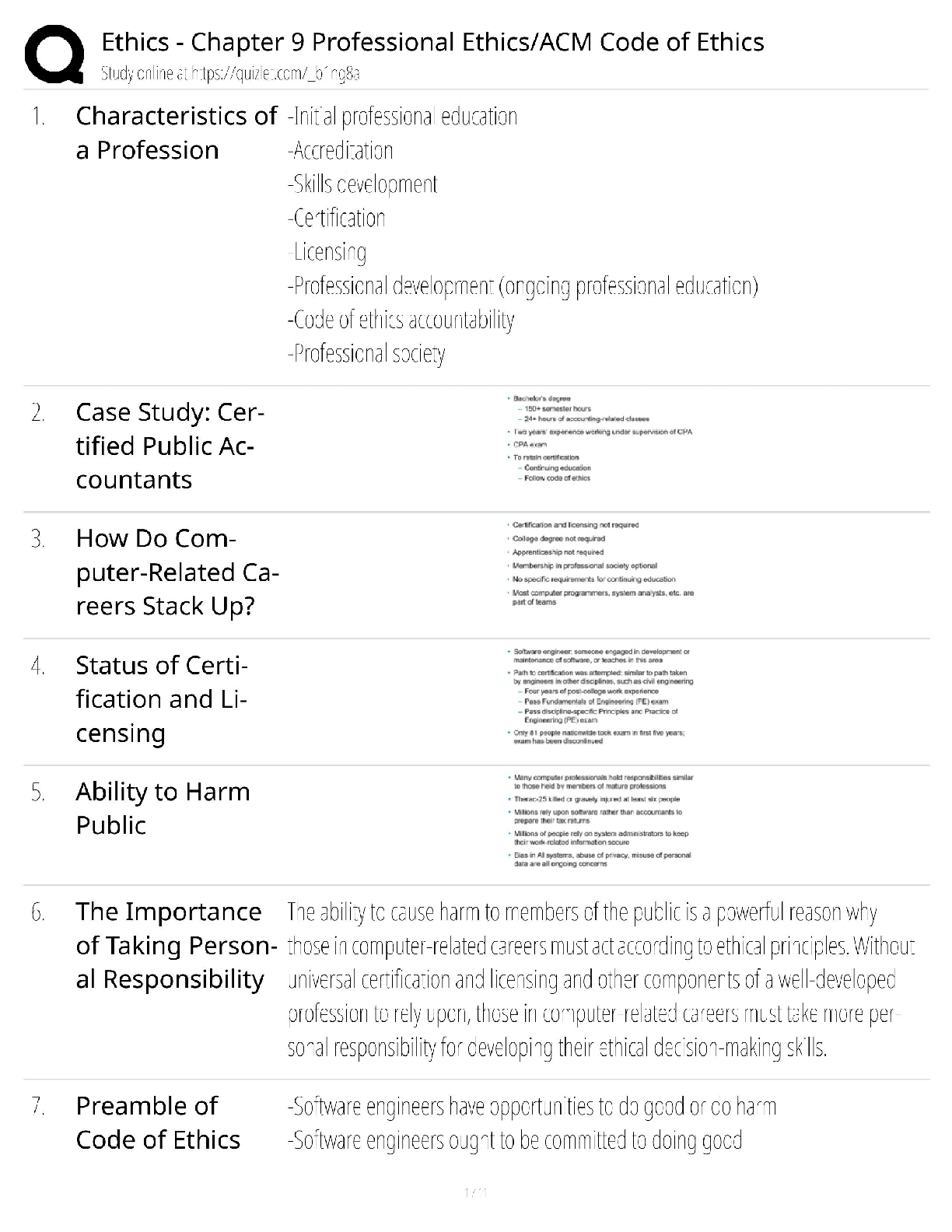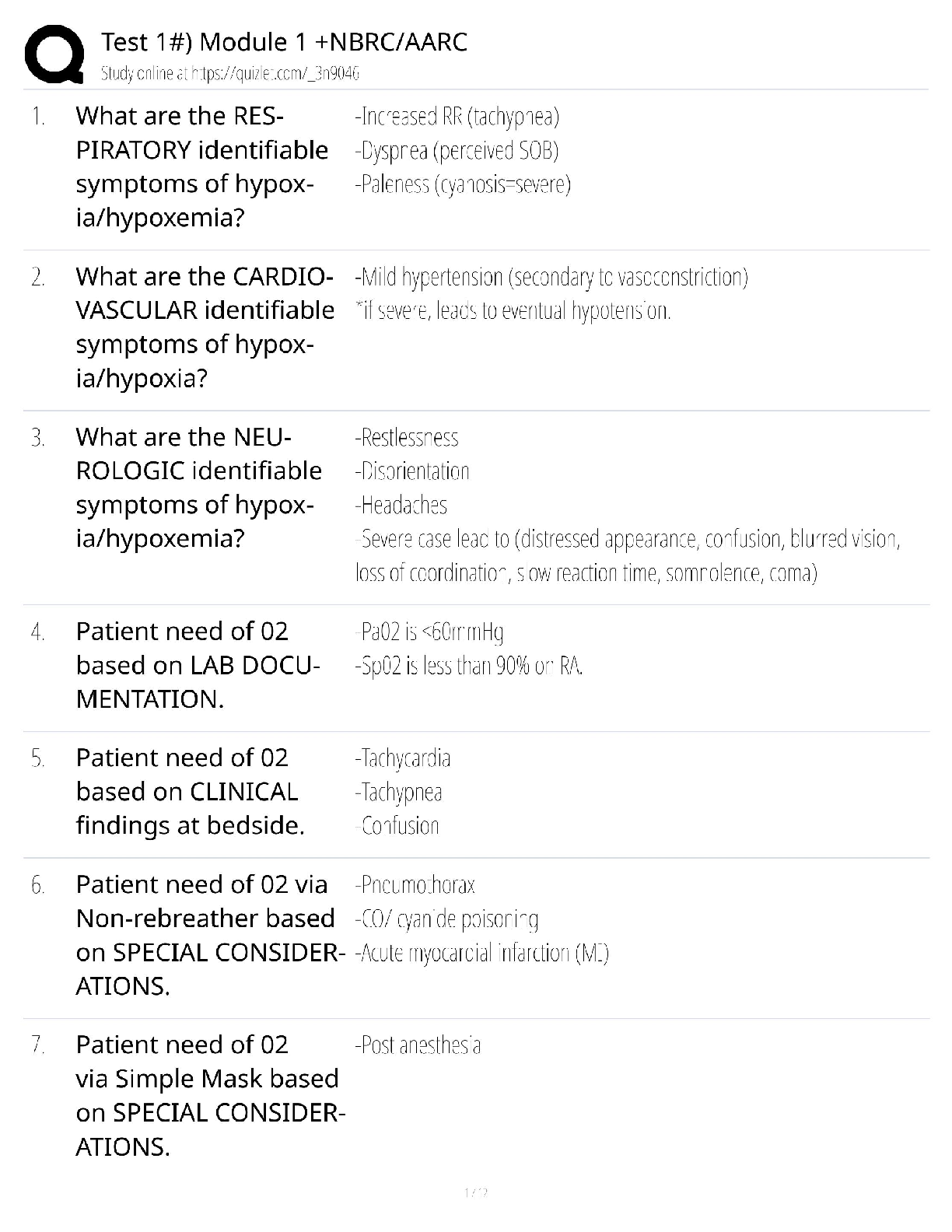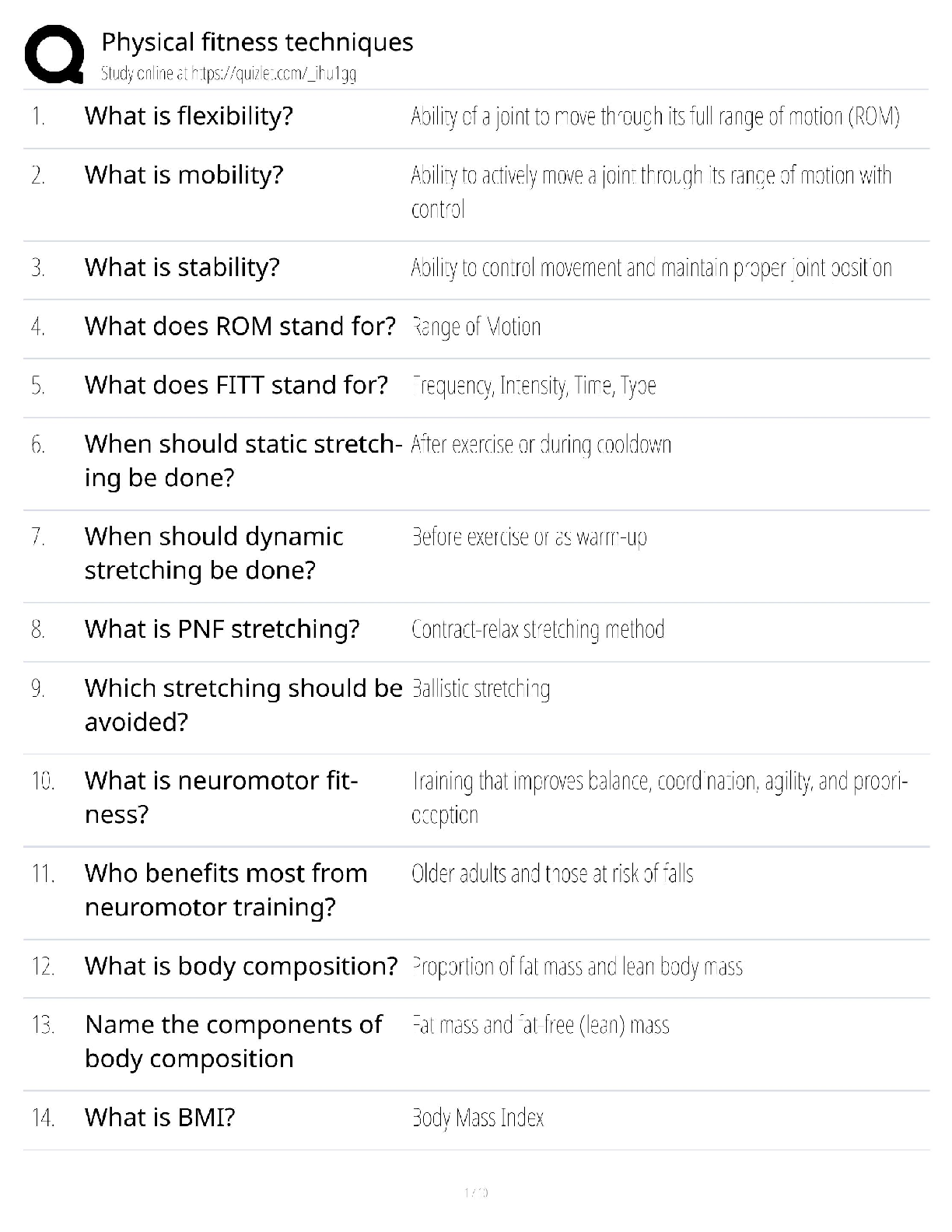*NURSING > QUESTIONS & ANSWERS > FNDH 620 Exam 2/Pop Quizzes 2022 – COMPLETE SOLUTION (212 Questions with 100% Correct Answers) (All)
FNDH 620 Exam 2/Pop Quizzes 2022 – COMPLETE SOLUTION (212 Questions with 100% Correct Answers)
Document Content and Description Below
FNDH 620 Exam 2/Pop Quizzes 2022 – COMPLETE SOLUTION (212 Questions with 100% Correct Answers) What are the most prevalent saturated fatty acids in the average US diet? A. palmitic and stearic a ... cid B. oleic and linoleic C. linoleic and linolenic D. acetic and butyric - ✔✔A. palmitic and stearic acid What is formed when fatty acids are oxidized in the mitochondria? A. glycerol B. pyruvate C. triacylglyceride D. acetyl CoA - ✔✔D. Acetyl CoA What is the normal product of fatty acid synthase? A. Triacylglyceride B. Palmitate C. n-3 fatty acid D. n-6 fatty acid - ✔✔B. Palmitate Which fatty acid is considered essential and must be supplied by the diet? A. a-linolenic acid B. Linoleic acid C. y-linolenic acid D. Arachidonic acidE. A and B - ✔✔E. a-linolenic acid and linoleic acid Humans build about ____mg of cholesterol each day. A. 100 B. 300 C. 700 D. 2000 - ✔✔C. 700 Cholesterol is a precursor of the following except A. Estrogens and androgens; B. Glucocorticoids; C. Bile acids; D. Vitamin D E. Phospholipids. - ✔✔E. phospholipids What is the most active site of lipid digestion? A. stomach B. duodenum C. upper jejunum D. ileum - ✔✔C. upper jejunum The main function of lipoproteins is A. To facilitate lipid digestion; B. To protect against CVD; C. To act as the carrier of lipids; D. To provide energy; E. All of the above. - ✔✔C. to act as the carrier of lipidsThe main component of a HDL, molecule is protein A. True B. False - ✔✔A. True LDL-cholesterol is often termed "bad cholesterol" because it has been linked to atherogenic fatty plaque formation A. True B. False - ✔✔A. True Trans unsaturated fatty acids are now considered more atherogenic than saturated fatty acids because they A. are unnatural and only formed during fat processing; B. cause excess blood clotting; C. elevate serum LDL while decreasing HDL; D. are saturated completely - ✔✔C. elevate serum LDL while decreasing HDL The mechanism of action of Orlistat is A. To inhibit pancreatic lipase activity; B. To destroy bile acids in the small intestine; C. To decrease appetite; D. None of the above; E. All of the above. - ✔✔A. To inhibit pancreatic lipase activity Why are n-3 PUFA the "best"? - ✔✔Interfere with platelet aggregation by inhibiting thromboxane production, reduces of pro inflammatory cytokines, What omega 3s are better, Short or long chain? - ✔✔Long chain, more consistently converted to antiinflammatory uses Which hormone is considered to be an antagonist of lipolysis?A. insulin B. epinephrine C. glucagon D. Adrenocorticotropic hormone E. None of the above. - ✔✔A. Insulin Excessive ketone bodies may accumulate due to reduced supply of cellular glucose as well as ____ fatty acid oxidation A. increase; B. decrease; C. no change. - ✔✔A. increase What is the legally intoxicated amount of alcohol in bloodstream? A. Less than 10 mg%; B. 11-24 mg%; C. 25-45 mg%; D. 50-100 mg%; E. None of the above - ✔✔A. less than 10mg% What happens when alcohol is metabolized by the liver? - ✔✔FA synthesis, leads to fatty liver Enzymes: A. decrease the free energy change of a reaction; B. increase the activation energy of a reaction; C. decrease transition energy; D. increase the equilibrium constant of a reaction; E. None of the above. - ✔✔C. decrease the transition/activation energy About ______ of the dry weight of a typical human cell is protein.A. one-tenth B. one-fifth C. one-third D. one-half - ✔✔D. one-half Which of the following statements concerning collagen is not true? A. Collagen is a major connective tissue protein; B. Collagen is made up of tropocollagen; C. Tropocollagen consists of three peptide chains that are cross-linked triple helix; D. Collagen has a large amount of glycine and proline; E. Collagen contains unique hydroxyglycine and hydroxyproline - ✔✔E. Collagen contains unique hydroxyglycine and hydroxyproline It actually contains hydroxylysine and hydroxyproline that are unique to collagen For each function listed in Questions 1-5, select the most closely related plasma proteins: 1. Nonspecific transport protein for fatty acids. 2. Inhibitor of elastase to protect against smoke induced obstructive lung disease. 3. Antibodies. 4. Major transport protein for copper. 5. major transport protein for iron - ✔✔1. Albumin 2. a1-globulins 3. y-globulins 4. a2-globulins 5. B-globulins A deficiency in which of the following amino acids will result in Kwashiokor, even though the diet may contain a large amount of protein A. Serine;B. Glutamate; C. Tryptophan; D. Alanine; E. Asparagine. - ✔✔C. Tryptophan Which of the following immunity functions is associated with a significant uptake of intact protein occurred in Small Intestine? A. Passive immunity during infancy; B. IgG protects against infection in uteri during neonatal period; C. IgA secrets in milk; D. IgM responds first to a new antigen; E. IgE is responsible for allergy. - ✔✔A. Passive immunity during infancy A patient came to the ER complaining of severe abdominal pain, Lab analysis revealed high conc. of dibasic amino acids in urine, Pain subsided a few hours later after he passed kidney stone. The most likely diagnosis for this patient is A. Hartnup; B. Cystinuria; C. Kwashiorkor; D. Hyperammonemia; E. Scurvy - ✔✔B. Cystinuria What percent of the circulation amino acids are contributed to protein synthesis? A. 9; B. 10-25; C. 30-40; D. 45-55; E. 75. - ✔✔E. 75%What is the first step in catabolism of amino acids - ✔✔transamination What is the second step in catabolism of amino acids? - ✔✔deamination In humans the major route of nitrogen transfer from amino acids into ammonia involves which of the following pairs of enzymes? A. Glutamine synthetase and urease; B. Transaminases and glutaminase; C. Glutamate dehydrogenase and transaminases; D. Amino acid oxidases and arginase; E. Glutaminase and amino acid oxidases - ✔✔C. glutamate dehydrogenase and transaminases Where is urea synthesized? A. brain and pancreas B. bones and joints C. stomach and duodenum D. liver and kidneys - ✔✔D. liver and kidneys Can BCAAs (branched-chain amino acids) be catabolized in the liver? - ✔✔No, liver doesn't have the enzyme needed The most branched-chain amino acids (i.g. valine, isoleucine, & leucine) are metabolized in the liver but not in the skeletal muscle. A. True B. False - ✔✔B. False Human body turns over the total body protein at about 10-20% (300-400g) each day? A. True B. False - ✔✔B. false, (1-2%, 30-40g)A def in which of the following amino acid will result in negative nitrogen balance, even though the diet may contain a large amount of protein? A. Serine B. Glutamate C. Tryptophan D. Alanine E. Asparagine - ✔✔C. Tryptophan, it is an essential AA Pellagra-like symptom may be induced by which of the following conditions? A. Incomplete dietary protein such as corn protein; B. Inherited defects in neutral amino acid transporter; C. Niacin deficiency; D. All of the above; E. None of the above. - ✔✔D. All the above, (incomplete protein intake, inherited defects in neutral AA transporter, and Niacin Def.) How long does it take for a fasting state? A. Up to 12 hours after meal; B. Up to 24 hours; C. Up to 48 hours; D. Up to 72 hours; E. Up to One week. - ✔✔C. up to 48 hours How long do hepatic glycogen stores last before exhaustion is reached? A. within 12 hours B. within 24-36 hours C. within 1 week D. within 1 month - ✔✔B. 24-36 hoursAmino acids from muscle breakdown provide the chief substrate for which metabolic process during fasting state? A. glycolysis; B. gluconeogenesis; C. glycogenesis; D. glycogenolysis; E. Hexosemonophosphate shunt - ✔✔B. gluconeogenesis A protein-sparing shift in metabolism from gluconeogenesis to lipolysis occurs during the? A. Fed state; B. Early fasting state; C. Fasting state; D. Starvation state; E. All of the above. - ✔✔D. Starvation state During exercise, which the following contributes only minimally to the amount of ATP used by working muscles? A. amino acids; B. muscle glycogen; C. blood glucose; D. Plasma fatty acids; E. Intramuscular triacylglycerides. - ✔✔A. Amino Acids The predominant use of plasma Free FA for energy is at low to moderate intensity exercise and the predominant use of glucose oxidation is at high intensity exercise. A. True B. False - ✔✔A. True What is the most important factor influencing the duration of endurance performance?A. muscle glycogen stores at the start of exercise B. muscle glycogen stores at the end of the exercise session C. muscle protein stores during the exercise D. the size of fat deposits at the beginning of the exercise session - ✔✔A. muscle glycogen stores at the start of exercise BMI is one way to estimate A. appropriate weight for height; B. actual body adiposity; C. body fat distribution; D. risk factors associated with obesity; E. None of the above - ✔✔A. appropriate weight for height In the reference man and woman, what percent of body weight is fat? A. 10, 20; B. 15, 27; C. 30, 40; D. 45, 55; E. None of the above - ✔✔B. 15% in men, 27 in women To prevent overweight and benefit for health, you need to exercise regularly and make smart choices from: A. less fat diet B. less carbohydrate diet C. less protein diet D. less total calories - ✔✔D. less total calories Lipids - ✔✔generally insoluble in water, but soluble in organic solventsSimple Lipids (Classification) - ✔✔Fatty acids (carboxylic acid) Tri-, di-, and mono-acylglycerols Waxes (sterol esters, nonsterol esters, etc.) Compound Lipids (Classification) - ✔✔Phospholipids Glycolipids lipoproteins Derived Lipids (Classification) - ✔✔substances derived from simple and compound lipids by hydrolysis Ethyl Alcohol (Lipids Classification) - ✔✔similar to lipid metabolism Fatty Acid Chains - ✔✔chains of carboxylic acid, varying from 4 to 24 carbon atoms. -short-chain FAs (2 - 4) -medium-chain FAs (6 -10) -long-chain FAs (12 - 24) Most FAs have an even number of carbon atoms. However, odd-numbered FAs occur in some food sources such as certain fish (tuna) and plants (olive oil). Fatty Acids - ✔✔they are amphipathic, composing of both hydrophilic and hydrophobic domains A FA may be 'saturated' with hydrogen, or 'unsaturated' -A carbon-carbon double bond provides an opportunity for either cis or trans form -Most naturally occurring unsaturated FAs are cis form -Most trans FAs are derived from partially hydrogenated vegetable oils and margarine. Monounsaturated Fatty Acids (MUFA) - ✔✔one double bond between carbon atoms usually nonessential, but may be one-third of total FA intake such as oleic acid.Polyunsaturated Fatty Acids (PUFA) - ✔✔multiple double bonds between carbon atoms (up to six). Trans Fats - ✔✔Most trans fats are created industrially in partial hydrogenation of plant oils, making a higher melting point for baking and extends shelf-life. However, trans fats have been associated with coronary heart disease risk by raising levels of LDL and lowering HDL cholesterol. Fatty Acid Notation - ✔✔Two systems have been interchangeably used to denote the chain length of FA and number/position of double bonds 1.Delta system: counts from carboxyl end (COOH) 2.Omega system (or n-system): from methyl end (CH3) image is the delta system Fatty Acids Nutrition Value - ✔✔FAs with 16 or more carbon atoms are most important both in nutritionally and functionally For example, palmitic acid (16:0), stearic acid (18:0), oleic acid (18:1), and linoleic acid (18:2) together account for 90% of the FAs in average US diet Fatty Acid Oxidation - ✔✔• activated in the cytoplasm by acyl-CoA synthase (-2ATP). • transport of fatty acyl-CoA into the mitochondria via an acyl-carnitine intermediate. • Once inside the mitochondrion the fattyCoA is a substrate for β-oxidation Fatty Acid Synthesis - ✔✔• The primary sites of fatty acid synthesis are liver and fat cells • Fatty acid synthesis from acetyl-CoA occurs in cytosol • acetyl-CoA from mitochondrion needs to move into cytoplasm for lipid and cholesterol biosynthesisFatty Acids Synthesis Steps - ✔✔• Synthesis of malonyl-CoA by acetyl-CoA carboxylase (ACC) is the first step • The acetyl-CoA and malonyl-CoA are transferred to acyl carrier protein (ACP) by acetyl-CoA transacylase and malonyl-CoA transacylase, respectively. • The synthesis of fatty acids from acetyl-CoA and malonyl-CoA is carried out by fatty acid synthase require NADPH • The primary fatty acid synthesized is palmitate (16:0) that is then undergo elongation and/or unsaturation to yield other fatty acid. If (essential) fat is entirely excluded from our diet, it could cause... - ✔✔Retarded growth, Dermatitis, Kidney lesions, or Early death Essential fatty Acids Two unsaturated FAs cannot be synthesized in our body due to lack of delta-12 and delta-15 desaturases. - ✔✔1.Linoleic acid (LA 18:2) is precursor for n-6 PUFAs such as y-linolenic acid (GLA, 18:3) and arachidonic acids (20:4) 2. a-linolenic acid (ALA 18:3) is precursor for n3 PUFAs such as eicosapentaenoic acid (EPA, 20:5) and docosahexaenoic acid (DHA, 22:6) Biosynthesis of Essential Fatty Acids - ✔✔see other flashcards Arachidonic Acid Synthesis - ✔✔see other flashcards Significance of Arachidonic Acid - ✔✔Precursor for eicosanoids including: •prostaglandins (PGs) •thromboxanes (TXs) •leukotrienes (LTs) Eicosanoids - ✔✔produce a wide range of biological effects on inflammatory responses, pain & fever, and reproductive function as well as regulating blood pressure, platelet aggregation, and thrombosisDietary Sources of PUFAs - ✔✔All edible fats contain some MUFAs, but various saturated FAs and PUFAs. Animal fats from sheep and cattle are largely saturated, whereas pigs and poultry have less saturated FAs and some PUFAs. Fish and plant oil are highly unsaturated. Fish are the major source of EPA and DHA whereas plant oils are the major source of ALA. Minor sources of PUFAs are nuts, seeds, vegetables, fruit, and egg yolk Triacylglycerol (triglyceride) - ✔✔Most of body fat About 95% of dietary fat Highly concentrated energy form Fats or oils (room temperature) - Long-chain SFAs --> solids - long-chain PUFAs (except for trans fat) --> oils Triacylglycerol Synthesis - ✔✔• Glycerol can be used directly in tissues other than adipose tissue • But adipocytes, due to lack of glycerol kinase, use dihydroxyacetone phosphate from glycolysis for triacylglycerol synthesis, indicating adipocytes must have glucose to make triacylglycerols. • The fatty acids are incorporated into triacylglycerols t [Show More]
Last updated: 3 years ago
Preview 1 out of 47 pages
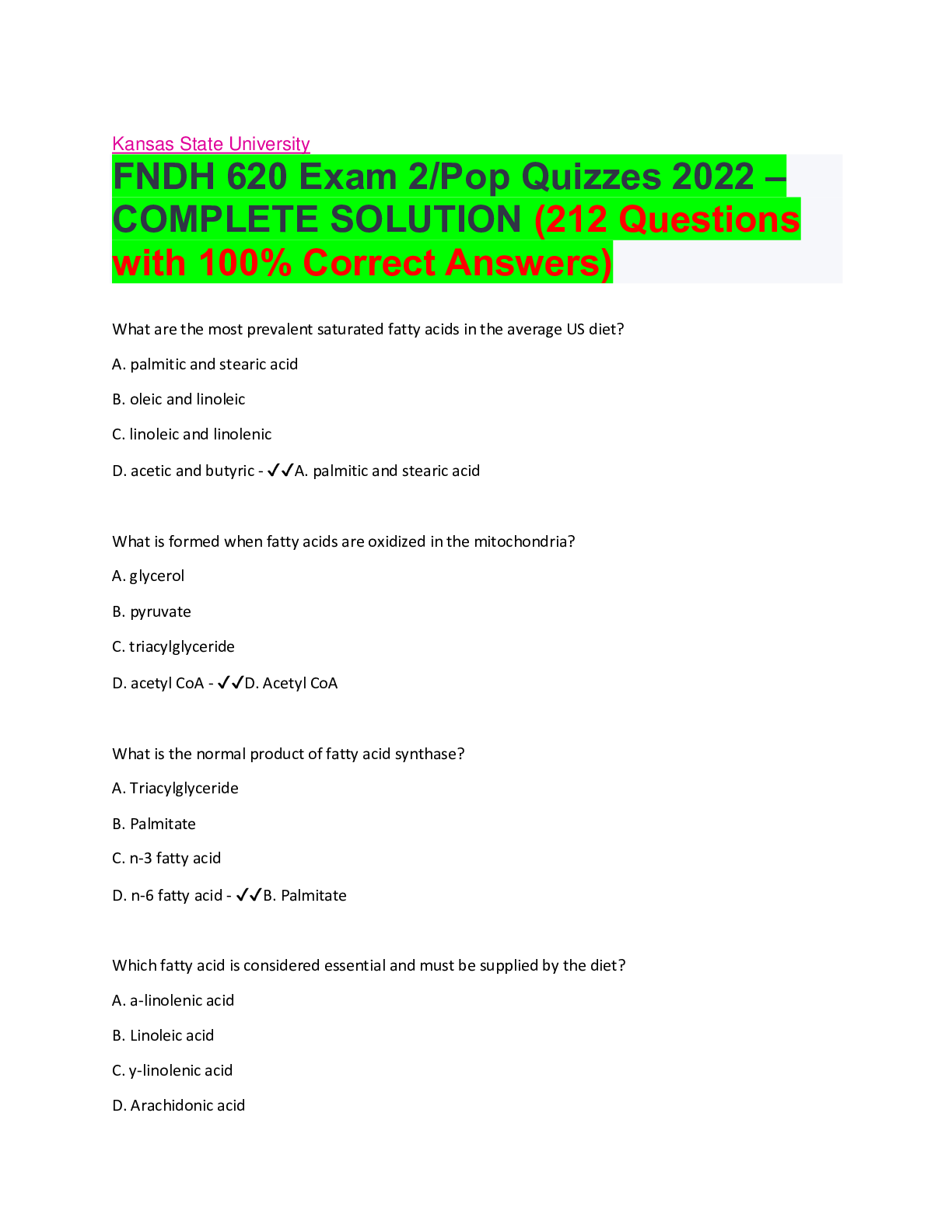
Buy this document to get the full access instantly
Instant Download Access after purchase
Buy NowInstant download
We Accept:

Reviews( 0 )
$8.00
Can't find what you want? Try our AI powered Search
Document information
Connected school, study & course
About the document
Uploaded On
Sep 04, 2022
Number of pages
47
Written in
All
Seller

Reviews Received
Additional information
This document has been written for:
Uploaded
Sep 04, 2022
Downloads
0
Views
120












